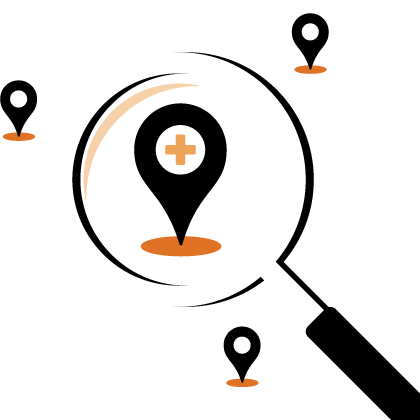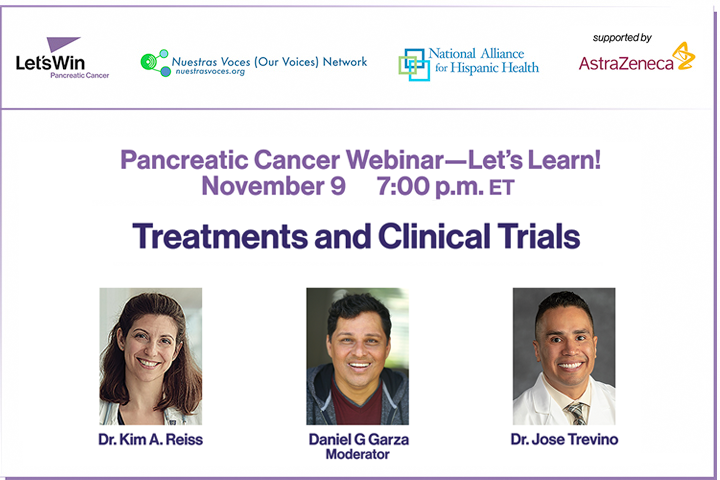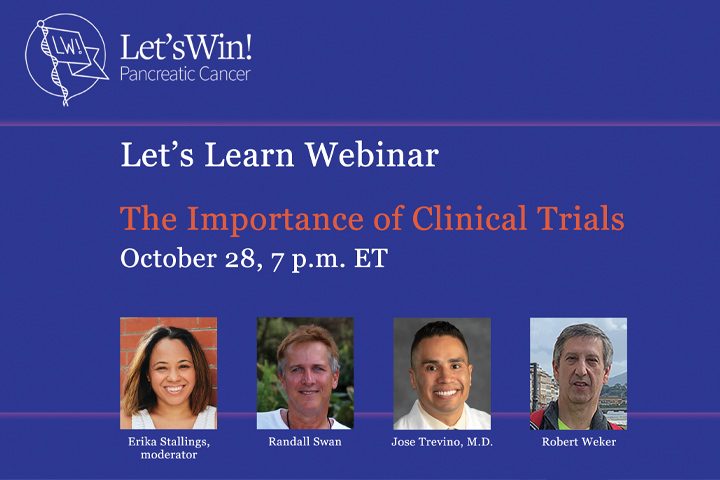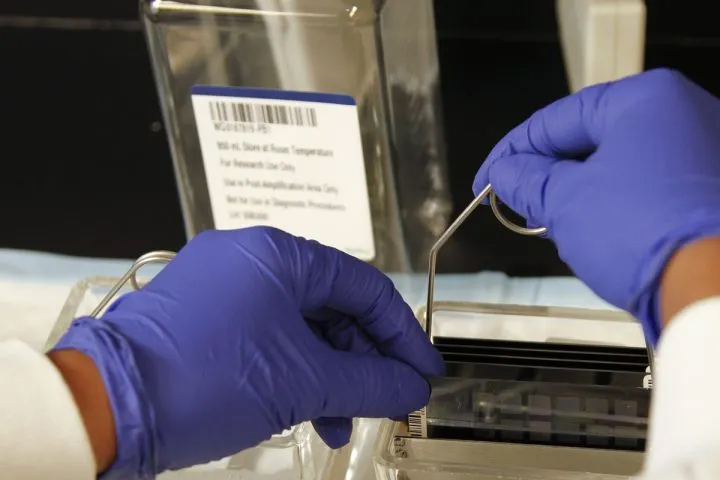Learn More About Qualifying for Clinical Trials
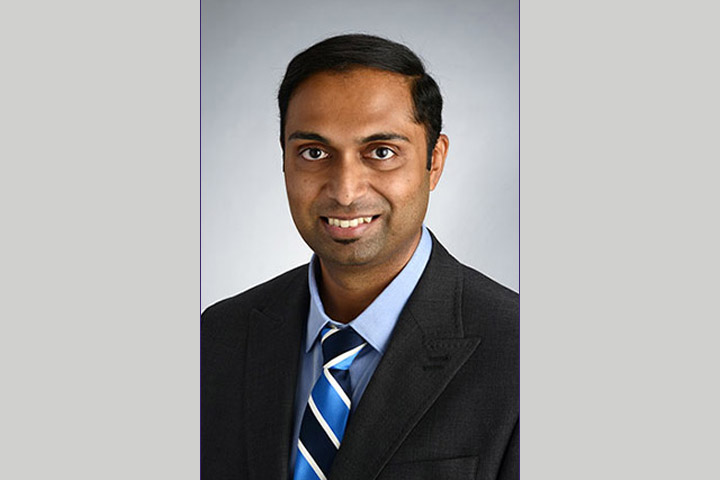
If you have pancreatic cancer, chances are you already know the odds of survival with standard treatment.
You might think that clinical trials are only an option after you have tried and failed every other possible option. But the fact of the matter is that nothing could be farther from the truth.
“What I’ve seen is that patients often have this notion that clinical trials are the last resort after they have gone through standard treatments,” says Anup Kasi, M.D., M.P.H., Associate Professor of Medicine, vice-chair of the GI-Disease Working Group, and director of the solid tumor molecular tumor board at Kansas University Cancer Center in Kansas City, Kansas. “Sometimes, patients don’t even ask about clinical trials when it’s a new diagnosis.”
However, he adds that the landscape is changing because more patients are asking about clinical trials when they walk through the door.
What Makes Cancer Clinical Trials Different?
Enrolling in a clinical trial for cancer might not strike you as an obvious treatment option because cancer clinical trials have some key differences in how they are run compared to clinical trials for all other conditions. For starters:
Clinical Trials for Cancer Rarely Include Healthy People
One important difference between clinical trials for cancer and trials for other conditions is that the effects of the treatments are not evaluated in healthy people. In most trials, healthy people are included in the first phase of the clinical trial, called phase I. Scientists use phase I trials to figure out whether a treatment is safe in a small group of people who do not have the condition.
Cancer clinical trials, on the other hand, seldom include healthy people.
Everyone in a Cancer Clinical Trial Gets Treated—No Placebo-Only Groups
Did you know that ethics play a crucial role in how clinical trials are designed? In fact, clinical trial proposals—especially those for cancer—are often sent to an ethics committee to make sure researchers design the study in a way that protects your basic rights.
An ethical approach improves the value of all clinical trials, and they carry even more weight when it comes to the study design of cancer clinical trials.
In a nutshell, this generally means that all patients participating in a cancer trial will receive treatment. Conversely, people enrolled in clinical trials for noncancer-related diseases may receive a sugar pill—also called a placebo—only, meaning they are not actually receiving treatment. In noncancer trials, the group that gets the placebo is called the control group.
“Noncancer trials are much more likely to have a placebo or placebo-only groups because the study has to establish safety and efficacy,” Kasi explains. “A majority of cancer trials have the standard treatment arm as the control group instead of the placebo.”
Here’s one key question that clinical trials for cancer address: Is it ethical not to treat a patient? In other words, is it right to give patients with cancer who participate in clinical trials a placebo only and deny them treatment altogether? For ethics committees, the answer is no.
Because cancer clinical trials rarely include healthy individuals, it makes sense that everyone enrolled in a cancer study receives some kind of treatment. Cancer clinical trials often compare a new treatment or new combination of treatments to the standard treatment.
However, this doesn’t mean that cancer patients in clinical trials never receive a placebo.
Depending on the study’s design, the group that receives the standard treatment may also receive a placebo instead of the experimental treatment. This may be done so patients do not know which group they are in. The patients may or may not know which treatments they are receiving—another feature that depends on how researchers design the study.
By the same token, Kasi says another important factor attributable to ethics is that you only see sick people enrolled in cancer clinical trials.
“Chemotherapy drugs are not benign,” he notes. “You don’t want to test chemotherapy drugs in healthy patients because of their potential side effects.”
Perhaps you’ve realized something if you have ever read a paper published by the scientists who ran a cancer clinical trial. You may have noticed that the study’s authors typically refer to the trial enrollees as “patients.” On the other hand, noncancer clinical trials—especially those phase I trials that evaluate safety in healthy patients—often refer to trial enrollees as “participants” or “subjects.” These labels make more sense since the trial participants are not actually sick. So technically they are not patients.
Cancer Clinical Trial Patients Are More Likely to Have Other Illnesses
Cancer and the treatments for it can cause many side effects and other health conditions. Examples include increased risk of infections, nausea, nerve damage, and heart failure. That’s because many treatments for cancer—chemotherapy, immunotherapy, radiation, even surgery—can have major side effects that can cause other health problems. This is not always the case in non-cancer clinical trials.
“In noncancer clinical trials, study participants may have high blood pressure but no other health problems,” Kasi explains. “However, cancer patients enrolled in clinical trials usually have cancer plus cancer-related conditions.”
And pancreatic cancer patients in particular may have other illnesses, since the average age at diagnosis is 70.
Now that you have some background on what makes cancer clinical trials different from noncancer clinical trials, let’s discuss what separates pancreatic cancer trials from other cancer trials.
Cancer Clinical Trials Are More Likely to Have Extra “Mini Phases.”
In general, there are four basic phases of clinical trials—three of which the U.S. Food and Drug Administration (FDA) requires before approving a drug.
- Phase I: These studies are the first ones done in humans. These are the smallest of the studies—usually ranging from 20-80 people. Researchers use this kind of study to figure out whether a treatment is safe and gather information about potential side effects.
- Phase II: If the data from the phase I study suggests a treatment is safe, then researchers run a phase II trial as the next step. Scientists use this trial to investigate who responds well to a treatment. They also continue collecting information about the treatment’s safety. Phase II trials involve a larger group of people, ranging from 100-300 participants. Ultimately, this phase serves as the proof of concept that a treatment actually works.
- Phase III: Promising results from a phase II trial mean the treatment will advance to the next step, phase III. During this trial, researchers continue collecting data on the safety and effectiveness of the treatment, as well as evaluating side effects. They also evaluate how the new treatment compares to standard treatment options. The number of trial enrollees ranges from 1,000 to 3,000.
- Phase IV: Just because a pharmaceutical company’s product is on the market doesn’t mean they stop studying their treatment. In fact, research continues even after the treatment reaches the market. Also known as post-marketing surveillance, this trial happens after the FDA has approved a drug and it’s on the market. Post-marketing surveillance often uncovers new safety information that manufacturers did not see because the studies they ran were smaller and may not have included the diverse population typical of the U.S.
The four phases listed apply to most treatments, regardless of whether they are for cancer or some other condition. However, when it comes to cancer studies, investigators may conduct extra phases that follow under phase I or phase ll as “subcategories.” For example:
Researchers use phase Ia to pinpoint specific information about the dose by trying to answer the following question: Whenshould we increase or decrease the dose? Scientists refer to this feature as dose escalation, de-escalation, or modification.
Kasi summarizes by saying, “At the end of the day, you need to find the maximum dose a patient can tolerate in a day.”
Phase Ib serves as what Kasi calls the “dose expansion phase.” This phase collects more data about the dose because more patients receive treatment with the dose researchers identified in phase Ia.
Phase IIb expands upon the proof of concept established in phase II. In phase IIb, researchers want to see if a drug causes a change in the tumor itself or in some sort of laboratory test result associated with the cancer.
Important Differences Between Pancreatic Cancer Trials and Other Cancer Trials
Not all clinical trials are meant for everyone with pancreatic cancer. “There are clinical trials for people who have stage I, II, or III pancreatic cancers,” Kasi explains. “The majority of patients who have pancreatic cancer are already stage IV by the time they’re diagnosed, so that in itself limits the number of studies,” he adds.
Not only that, but pancreatic cancer has some unique features that make it a little tricky for you to qualify for a clinical trial.
Pancreatic Cancer Patients Have More Symptoms than Patients with Other Cancers
“Pancreatic cancer patients tend to have more symptoms than other types of cancer,” Kasi notes. These include symptoms associated with diabetes, including neuropathy and blurred vision; malnutrition related to decreased pancreatic enzymes; higher levels of certain inflammatory proteins called cytokines; and muscle loss, caused by cachexia. Some of these symptoms may be related to the chemotherapy a patient has been given. For example, neuropathy is a common side effect of certain drugs included in the standard of care for pancreatic cancer.
Scar Tissue Makes Clinical Trial Enrollment Difficult—Especially in Pancreatic Cancer
Pancreatic cancer automatically causes your body to form scar tissue, called fibrosis. This hardened tissue can make it harder to find cancer cells with a biopsy. Not only does it make diagnosing pancreatic cancer more difficult, but it can spell trouble if you’re trying to qualify for a clinical trial that requires a biopsy to identify biomarkers in the tumor.
“Some clinical trials for pancreatic cancer are biomarker-driven,” Kasi explains. “So, patients are only eligible if their cancer has certain biomarkers that are the markers for the clinical trial.”
Late-Stage Diagnoses, Overly Strict Criteria Make Finding Participants a Challenge
Because pancreatic cancer is usually diagnosed at an advanced stage, patients are often sicker. This makes it even harder to qualify for a trial, because many trials have very strict participation criteria.
Kasi explains that there are many conditions that currently limit trial participation. Energy level and day-to-day functioning are considered when a patient is joining a clinical trial. “Cachexia impacts patients’ energy level. They may be sick due to bile duct obstruction, stomach obstruction, infection, uncontrolled sugars, pancreatitis, pancreatic enzyme deficiency resulting in food malabsorption and malnutrition.” Protocols often exclude patients whose lab tests and blood work are not in the normal range. For example, a pancreatic cancer patient with bile duct obstruction may have elevated liver enzymes.. Kasi adds, “Certain trials may not allow patients with neuropathy.”
Some trials either limit the number and type of prior therapies or have requirements for specific therapies before enrollment.
There is some discussion about whether certain exclusion criteria are too strict. Kasi cites time-based washout periods (the period of time required to go without treatment before starting the trial—to clear the body of previous treatments) as one example. Washout periods are required from clinical trial eligibility criteria in most cases. But “some pancreatic cancers are aggressive and may progress if we wait for extended washout periods. So relevant clinical and laboratory parameters should be used in place of time-based washout periods to address safety considerations,” he adds.
Cost Fears, Misinformation, and Mistrust Cause Some Patients to Avoid Clinical Trials
Over the last few years there has been an increased focus on diversity in clinical trials.
Historically, clinical trial enrollees have been mostly white males—unless the condition affected mainly women. Then the participants would be mainly female, but most were still white.
To this day, few clinical trials include many people who identify as Black, Indigenous, or other People of Color (BIPOC), if any at all. While the medical community now acknowledges the problem, cultural barriers and distrust prevent many members of the BIPOC community from enrolling in clinical trials for pancreatic cancer as well as other cancers and noncancer conditions.
Kasi stresses that this challenge gives medical professionals and researchers an opportunity to get more people of color on board.
“Education and guidance from the physician and clinical trial investigators is helpful in overcoming distrust and low enrollment in certain communities,” Kasi says. “I try to have my patients talk with other people of color who’ve done clinical trials as well as physicians of color.”
Many patients may avoid clinical trials because they fear the financial costs. Kasi explains that in clinical trials the costs are covered for treatments and any special tests required as part of the trial. Some trials may even pay for travel expenses, including mileage. But participants may have extra clinic visits and lab work. Kasi says that clinical trials may require more doctor visits, but it’s a small price to pay for extending your life.
Understanding clinical trials can be a challenge. But as you learn more about how trials work, you should feel empowered to talk to your doctor about participating



